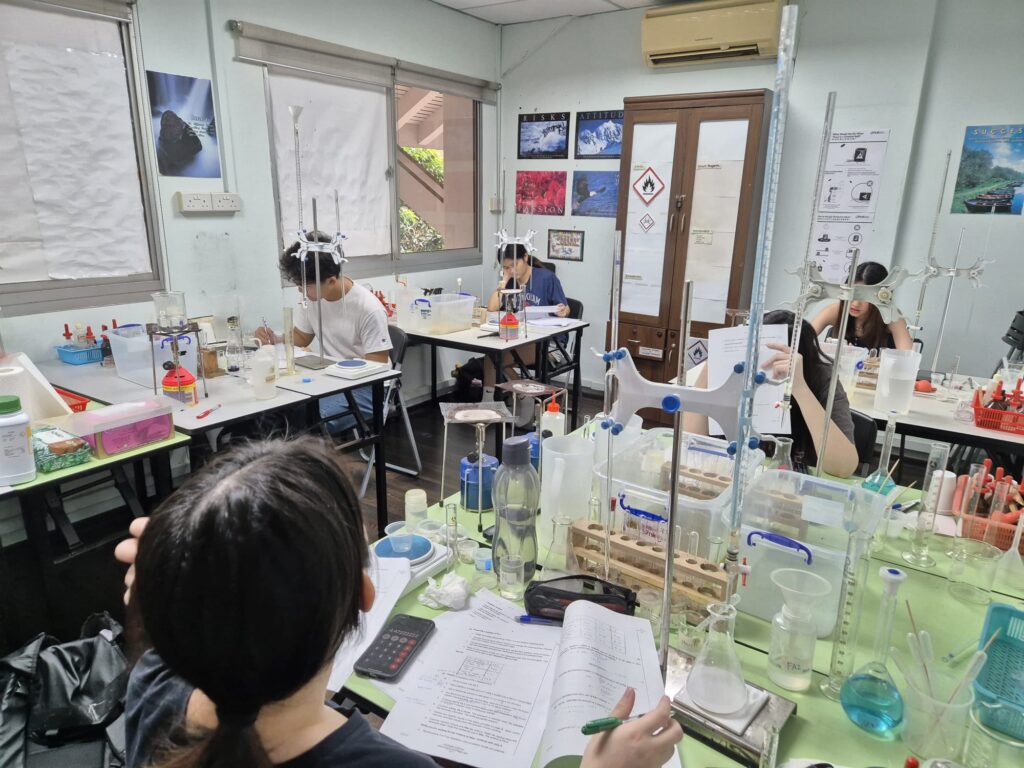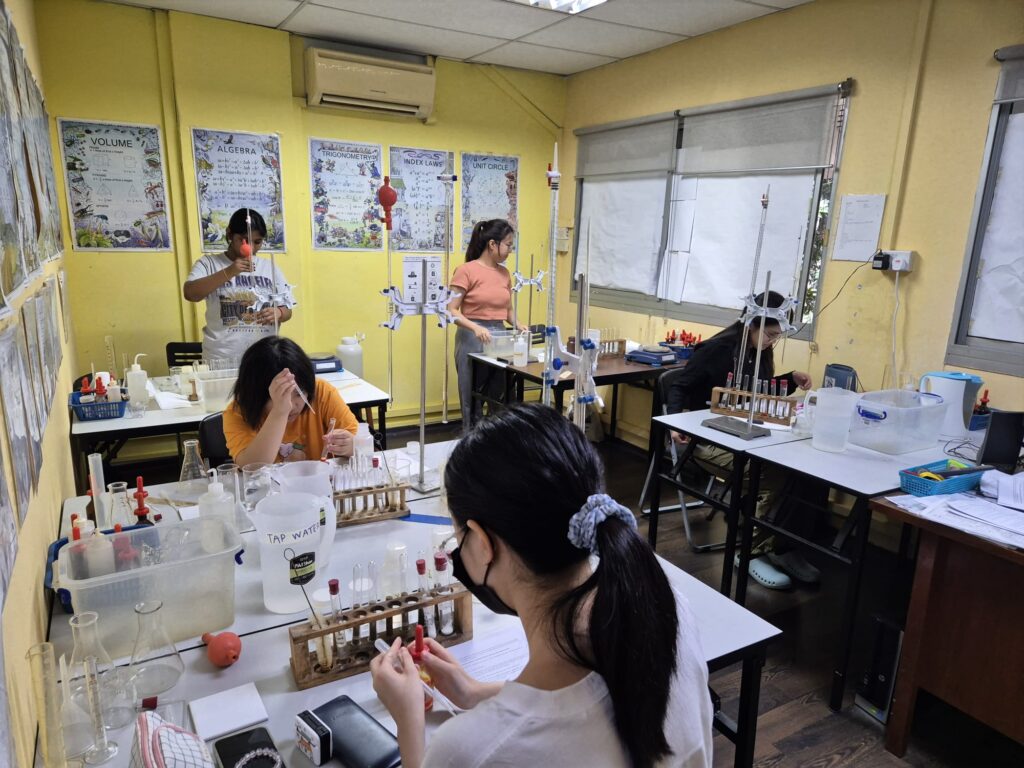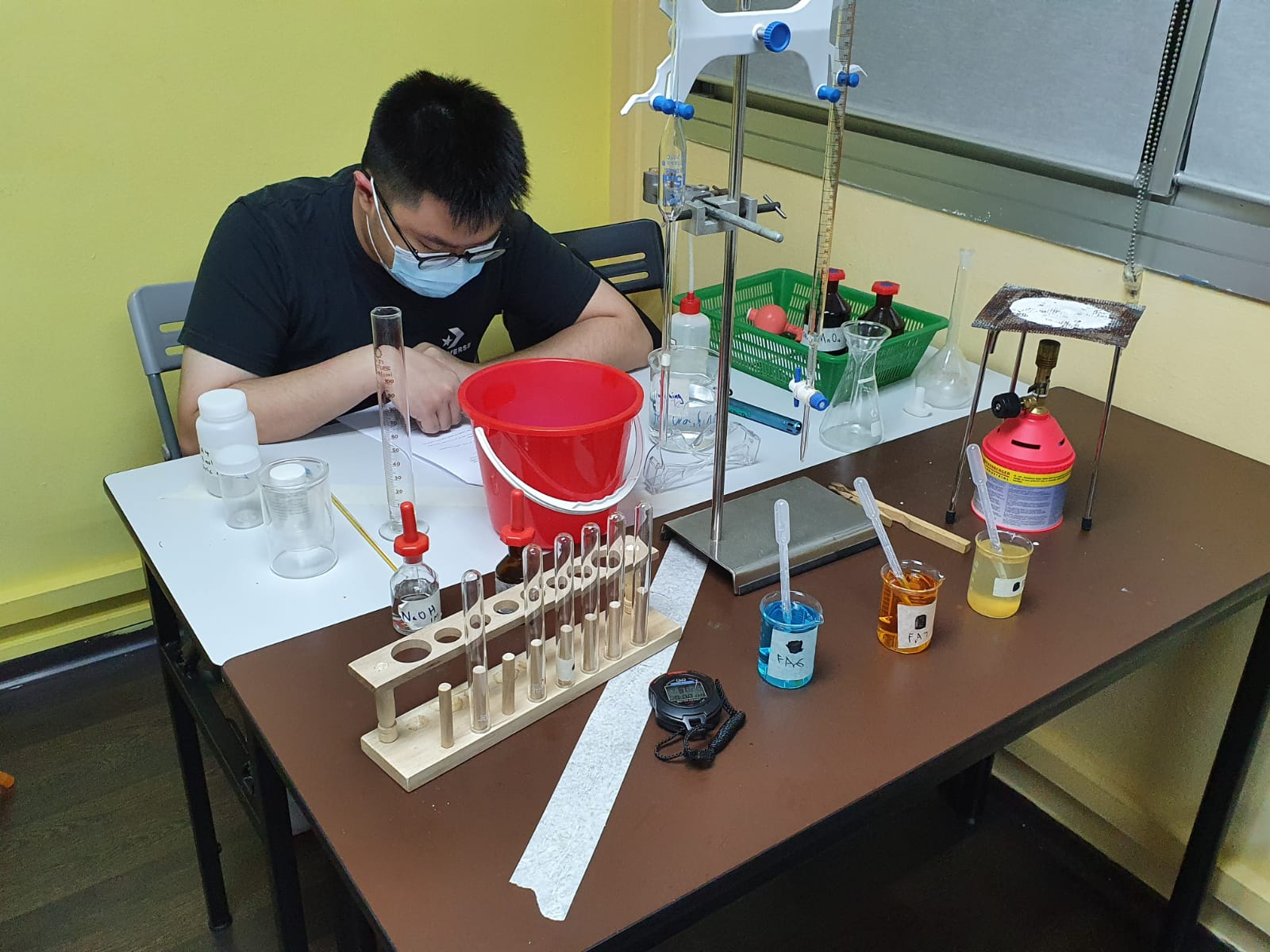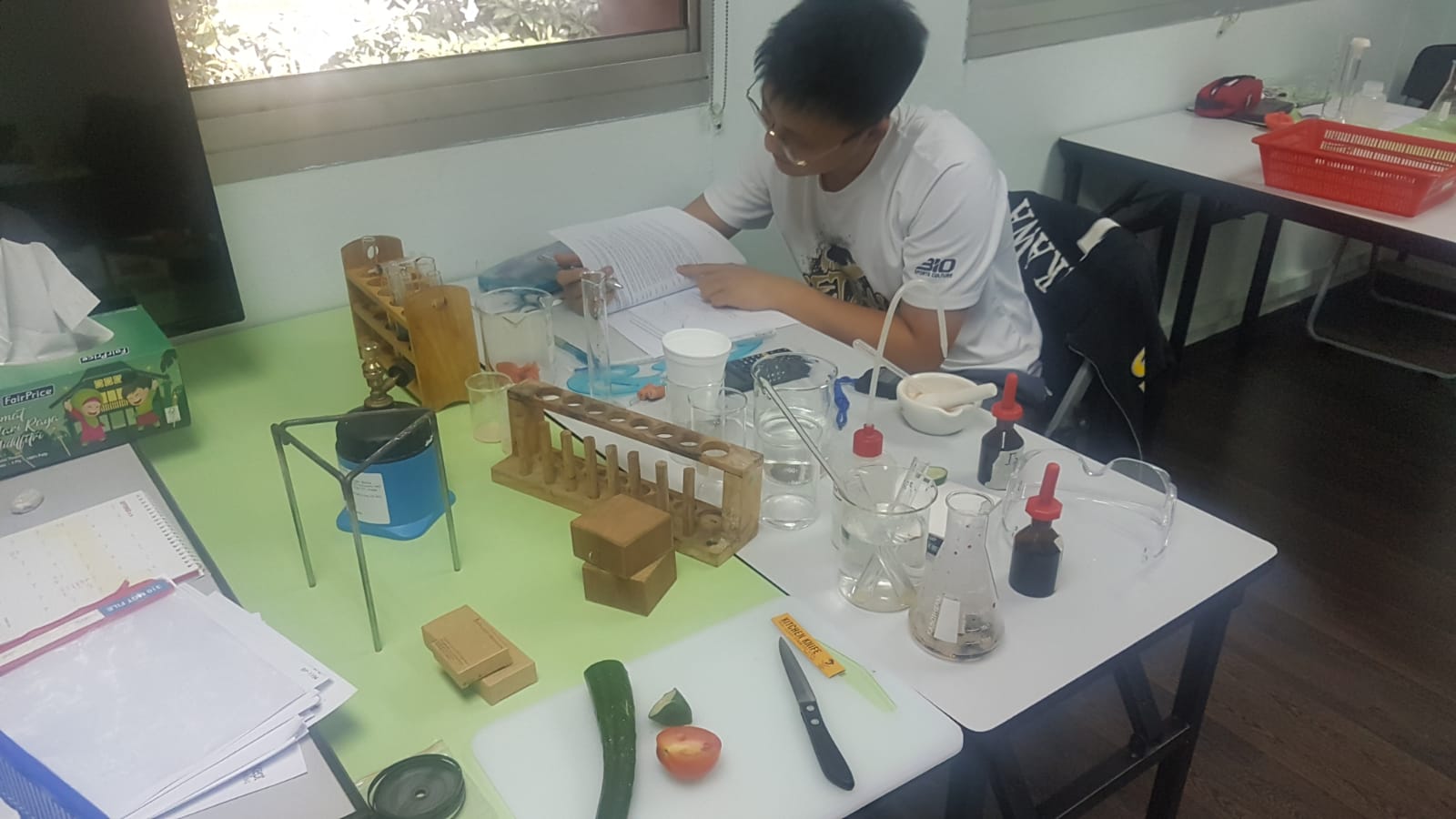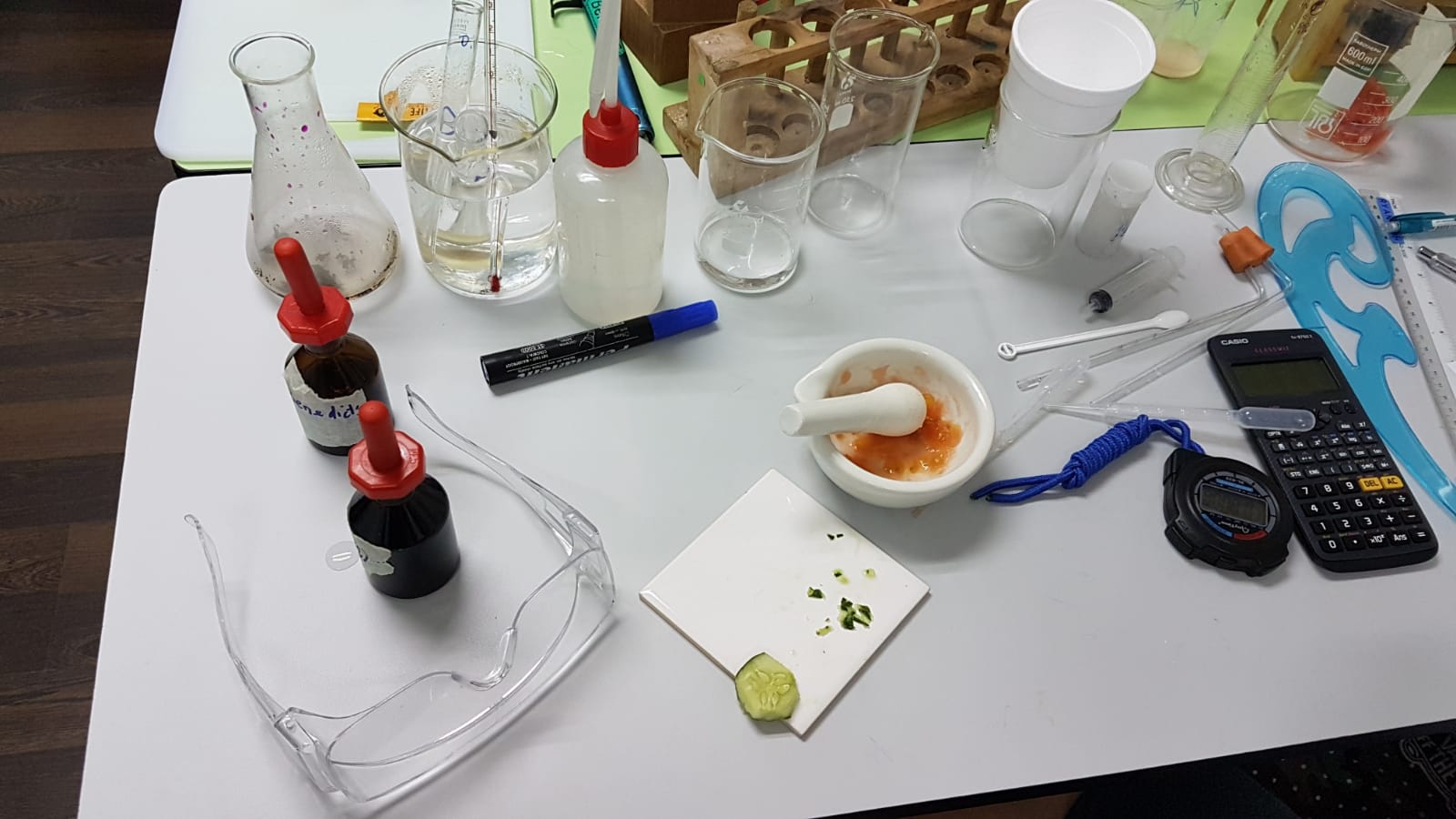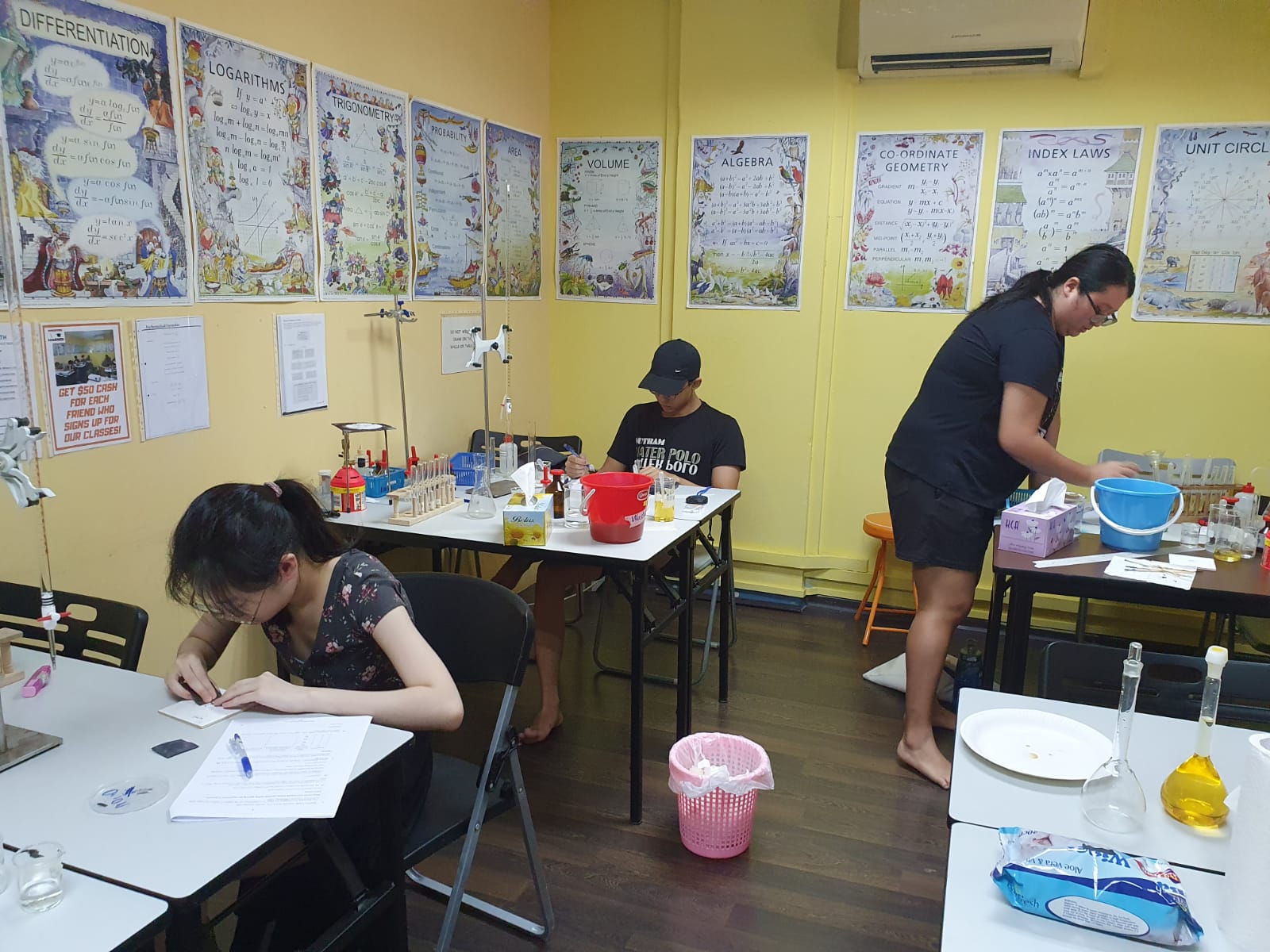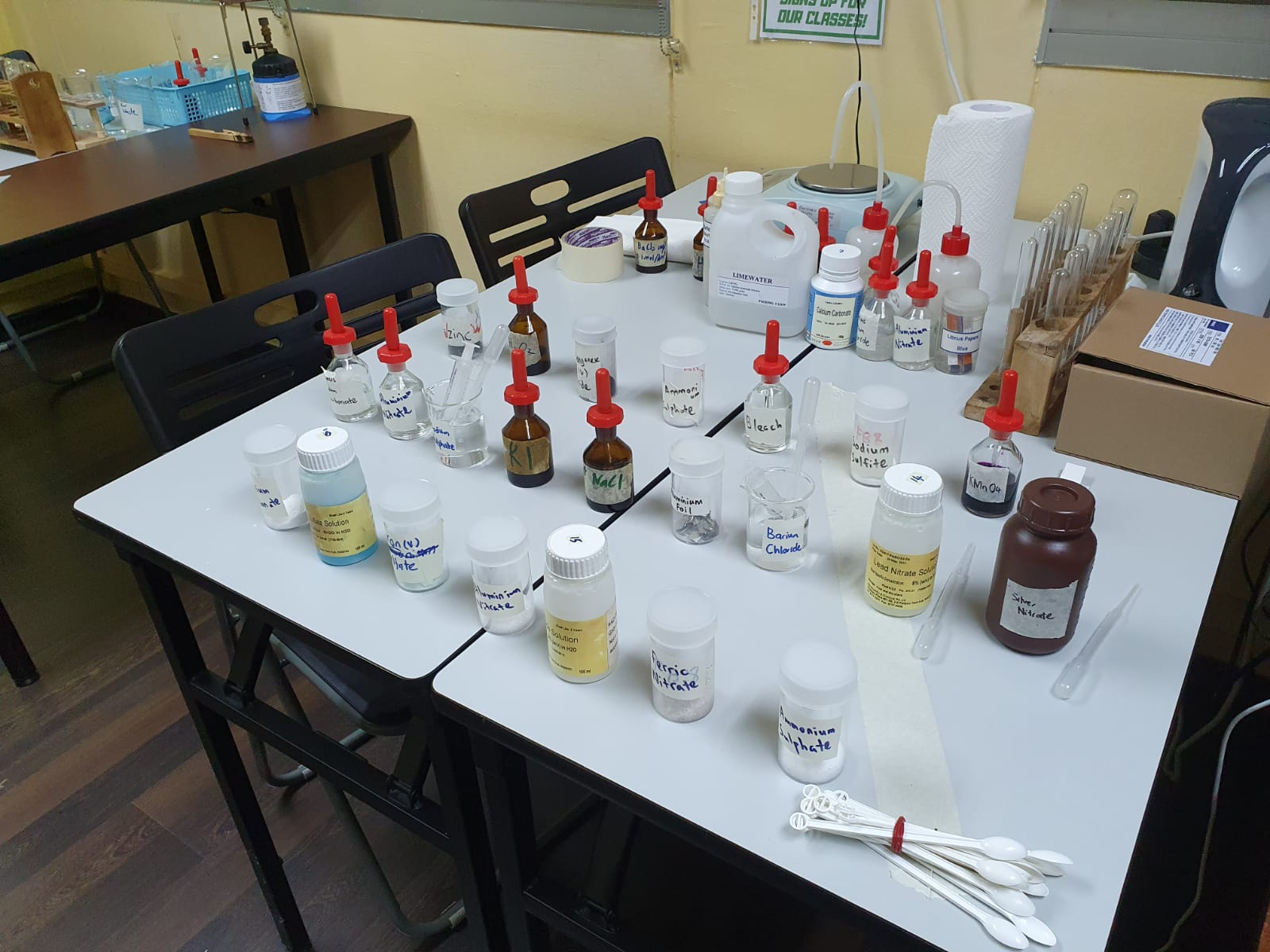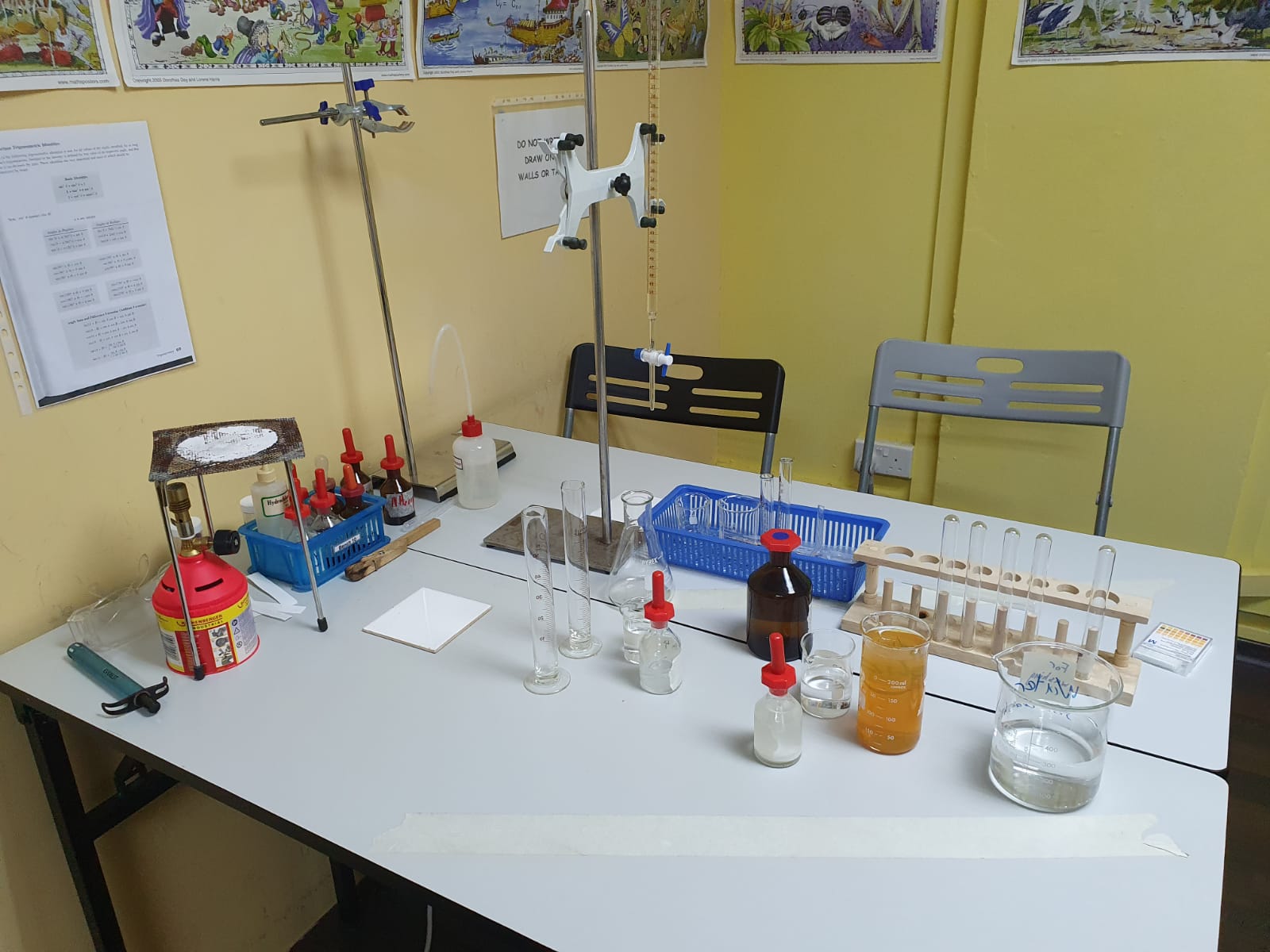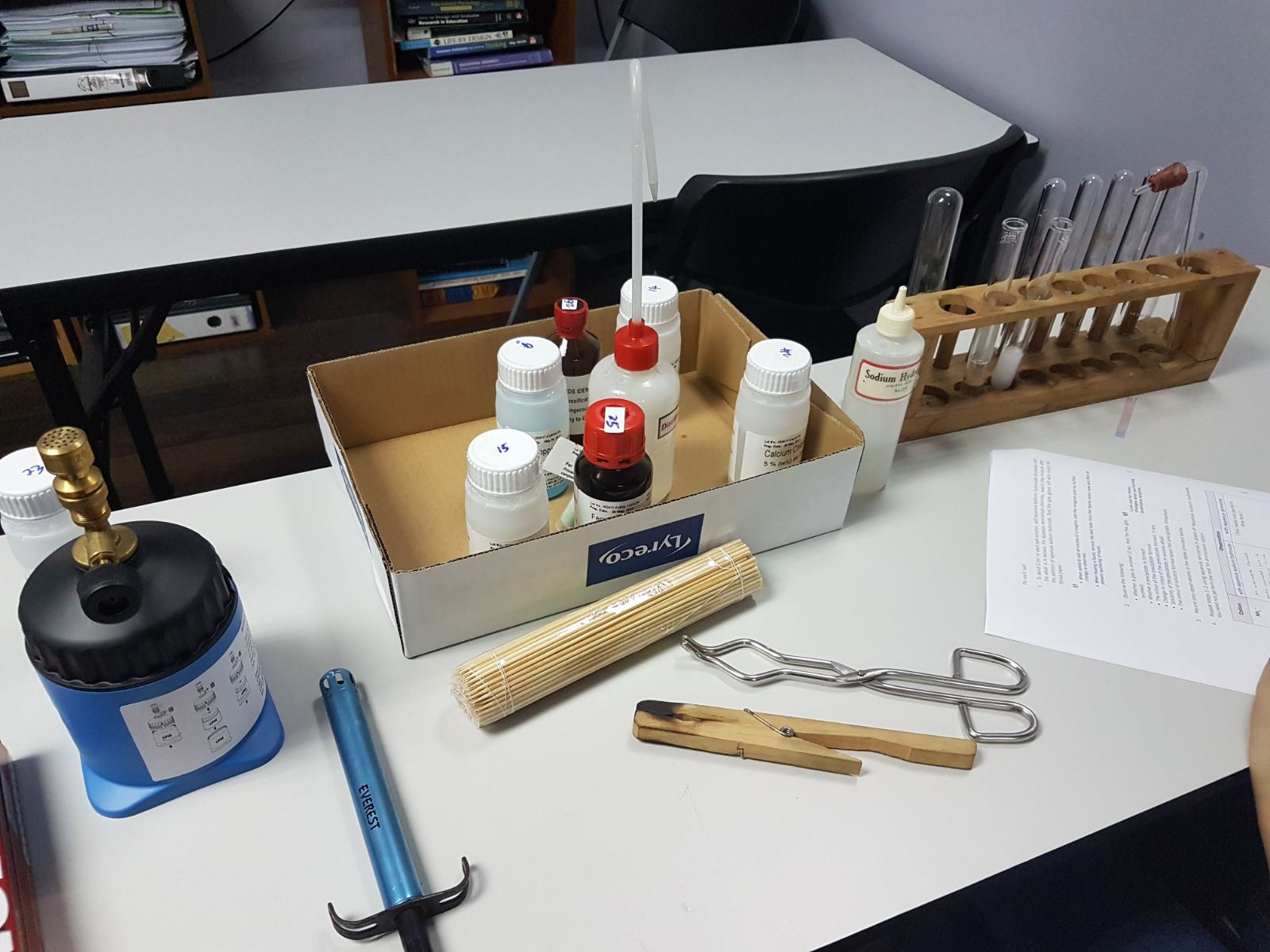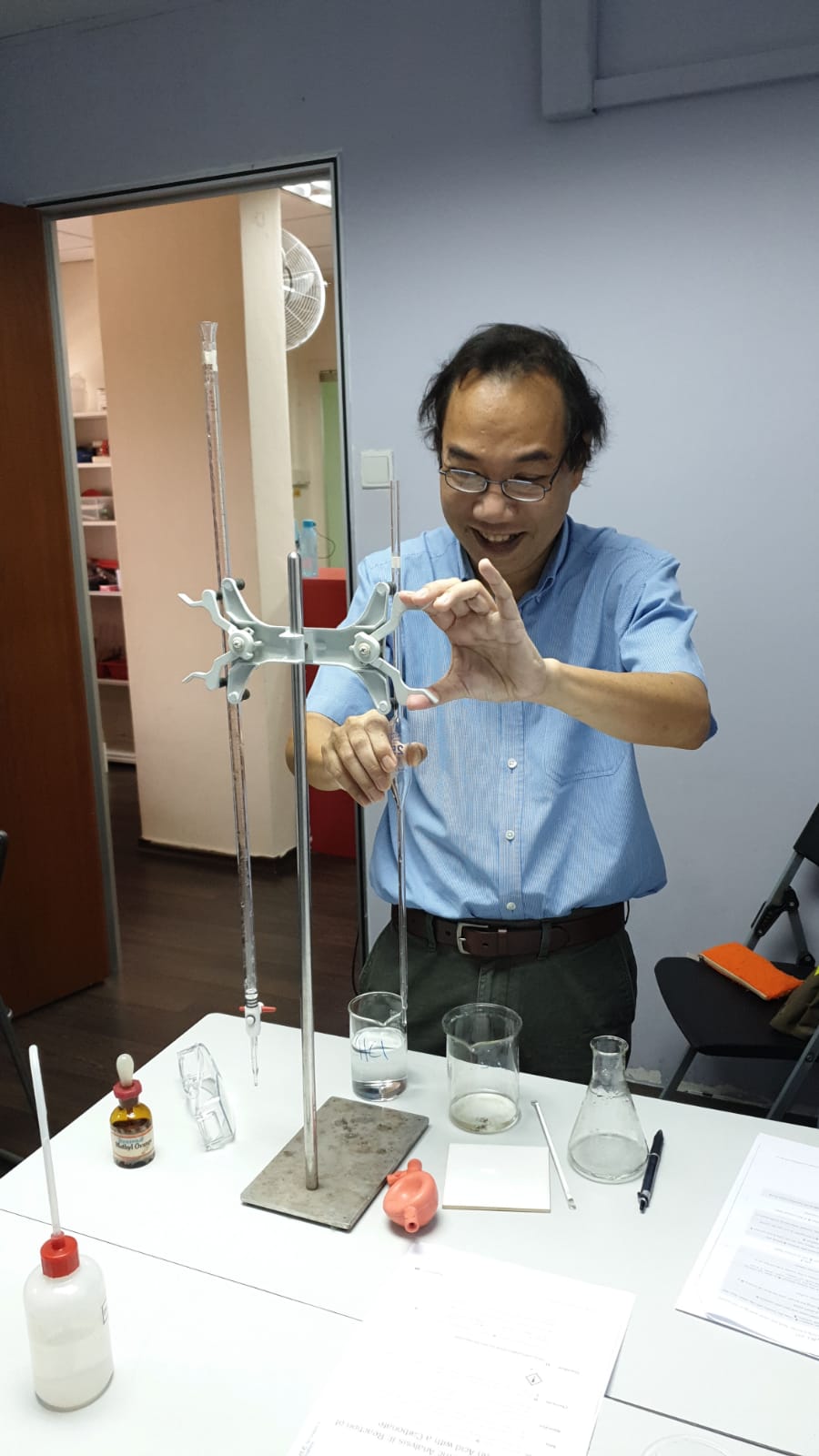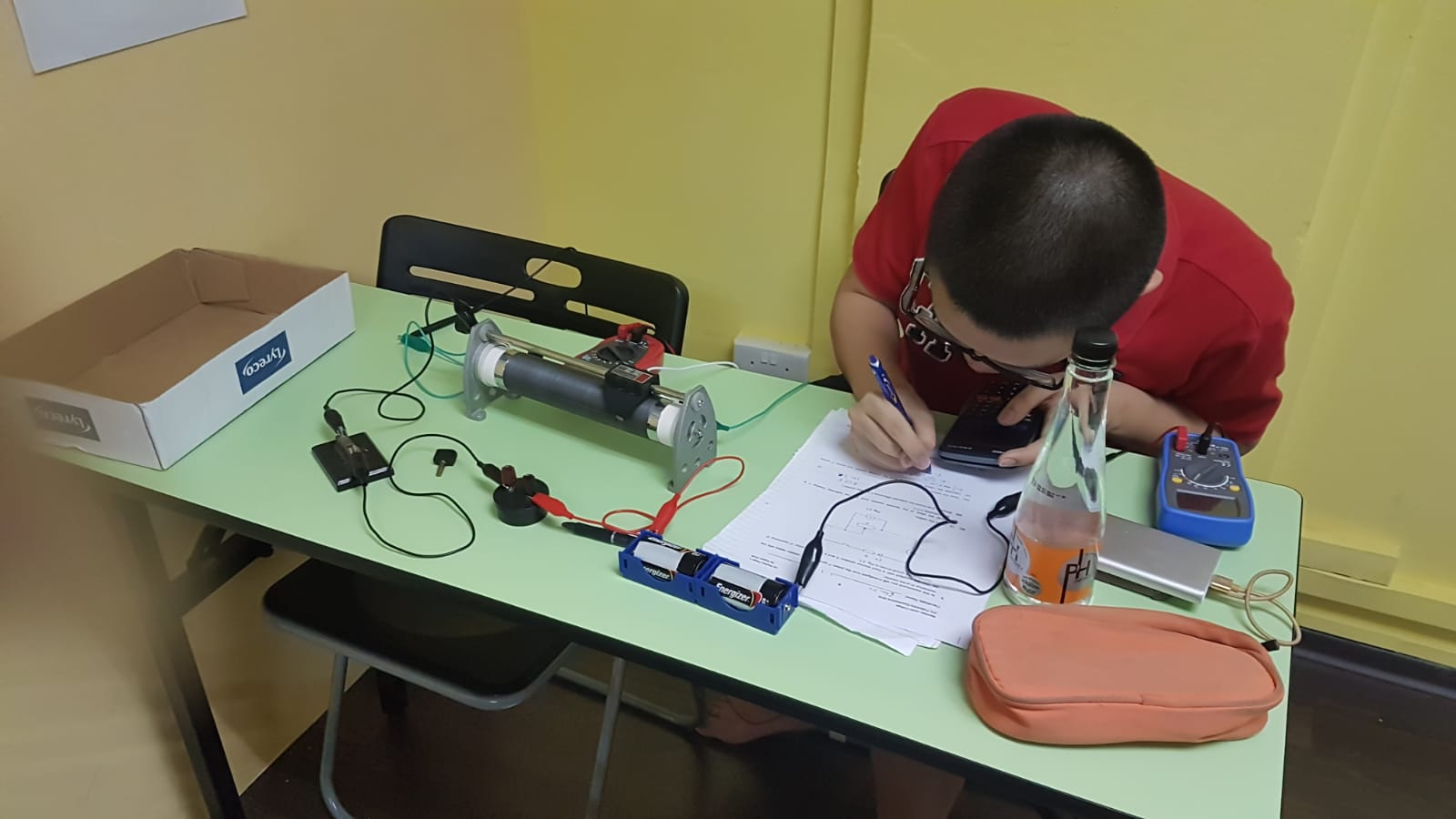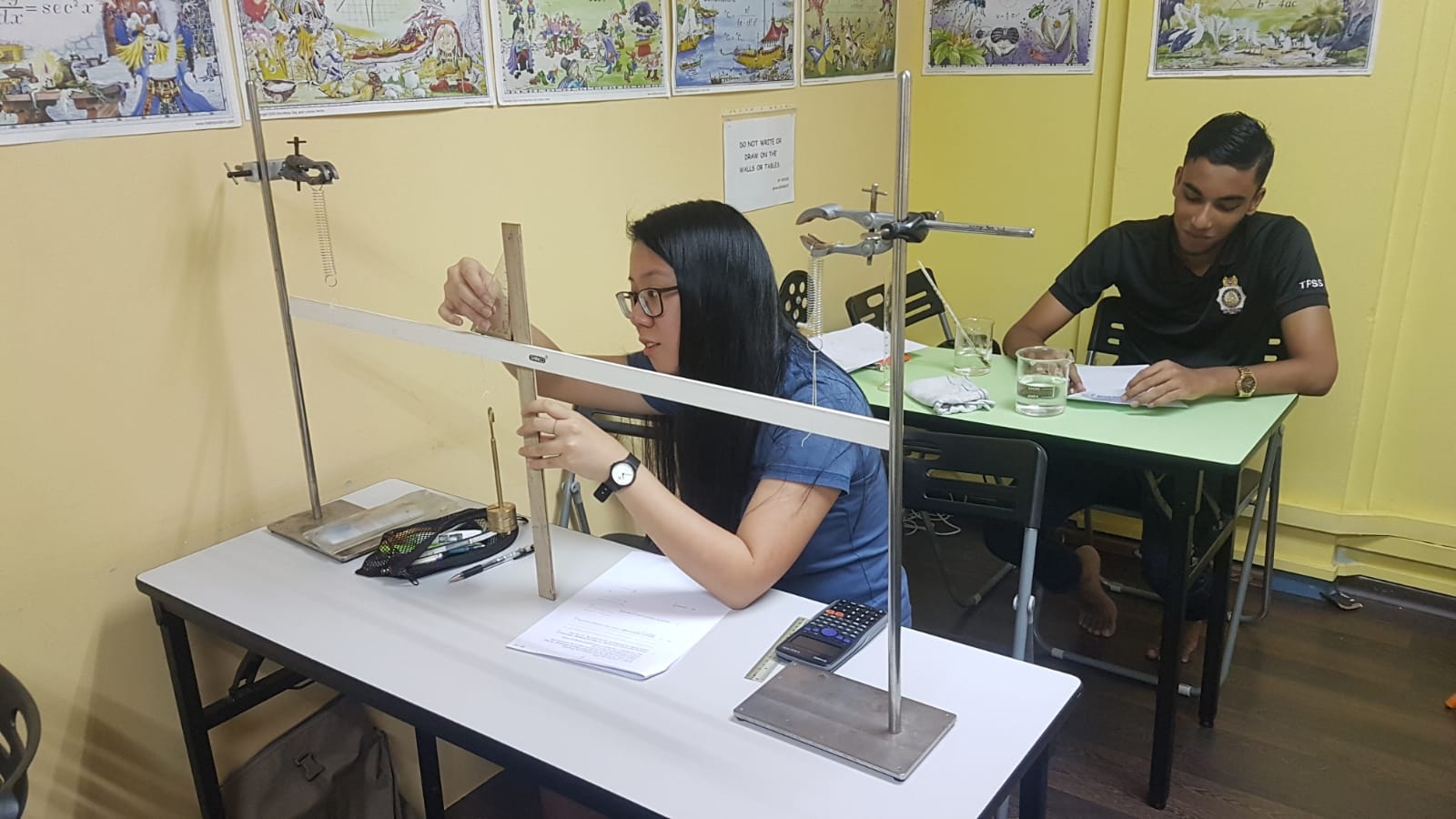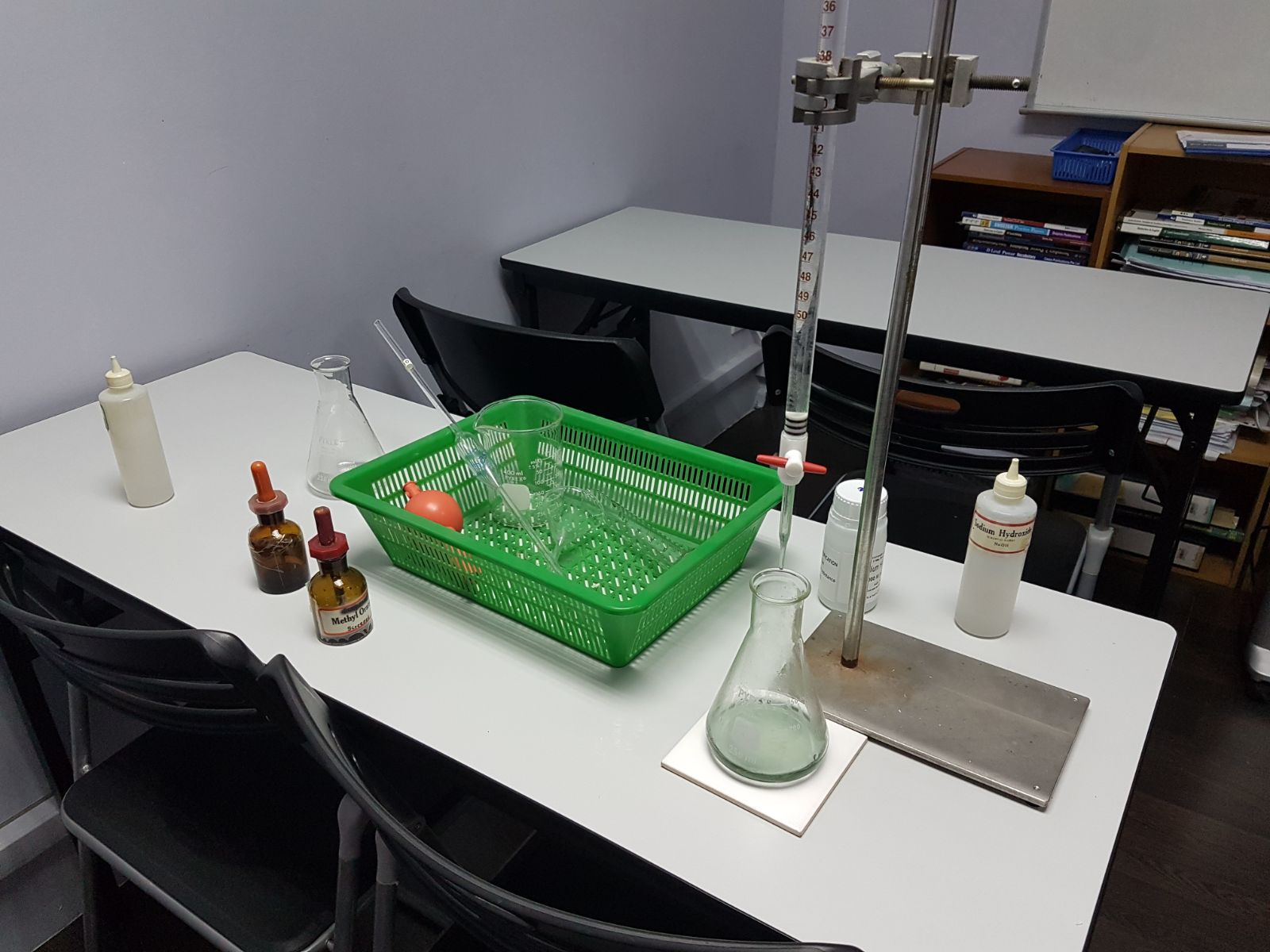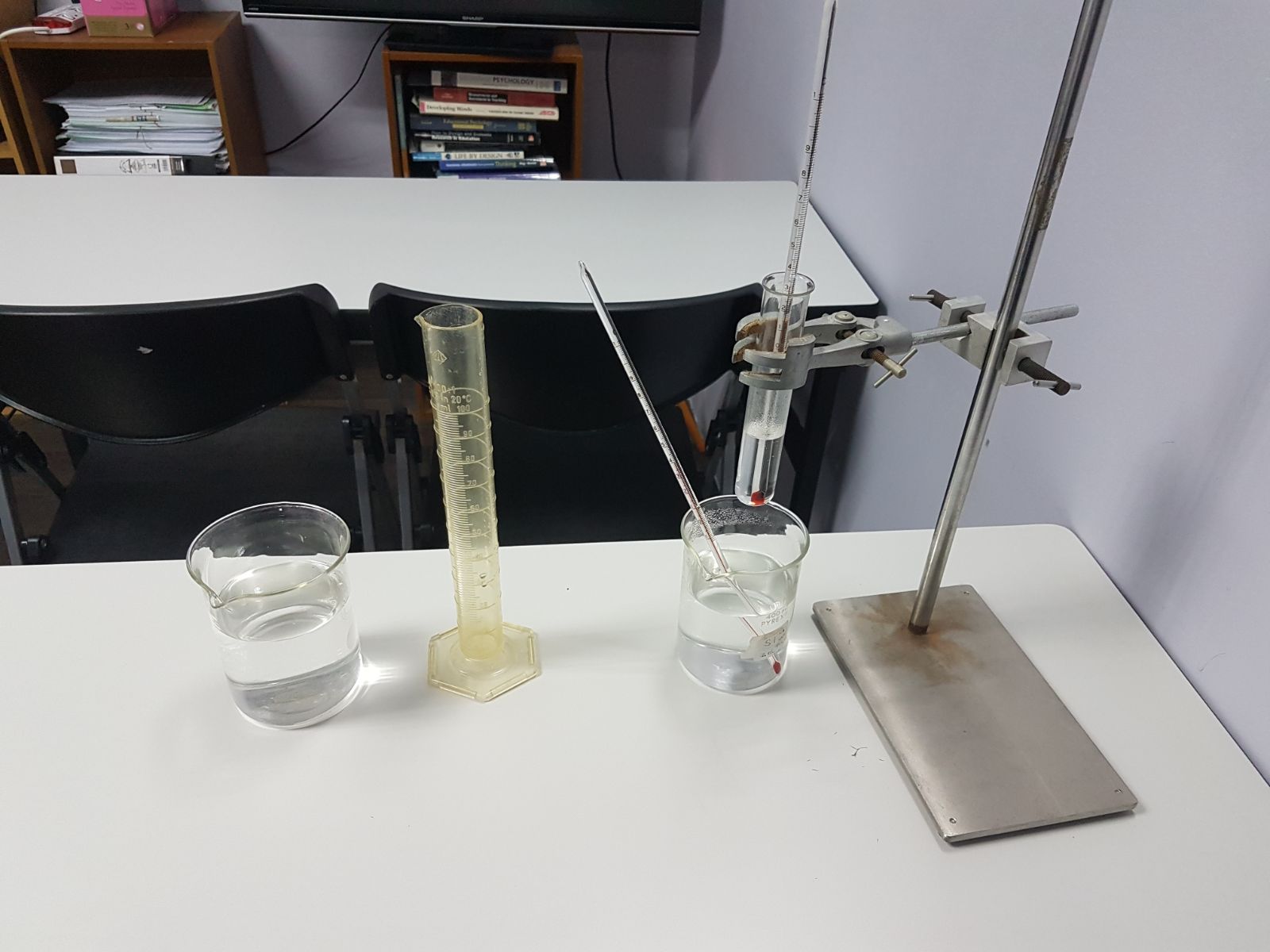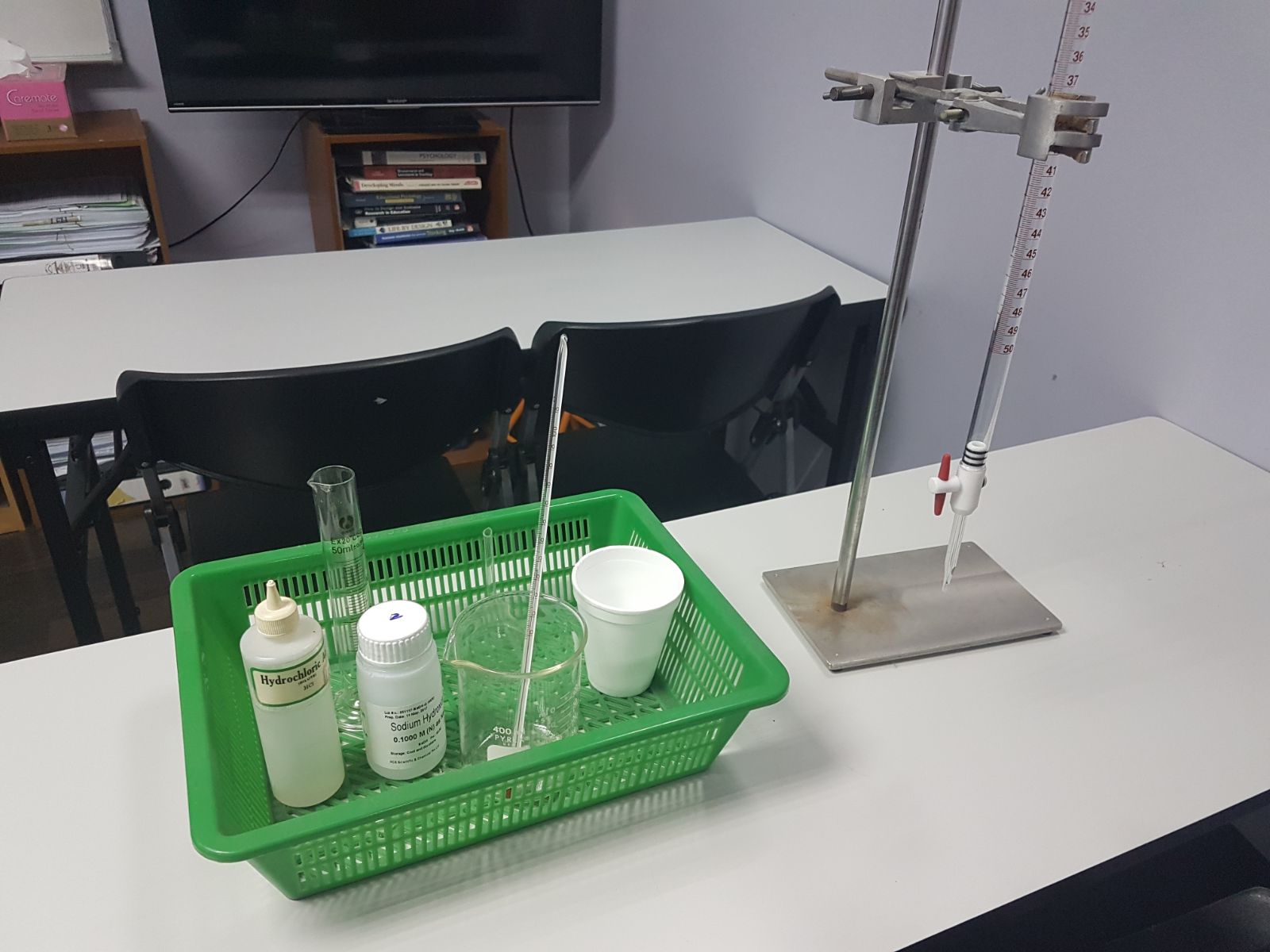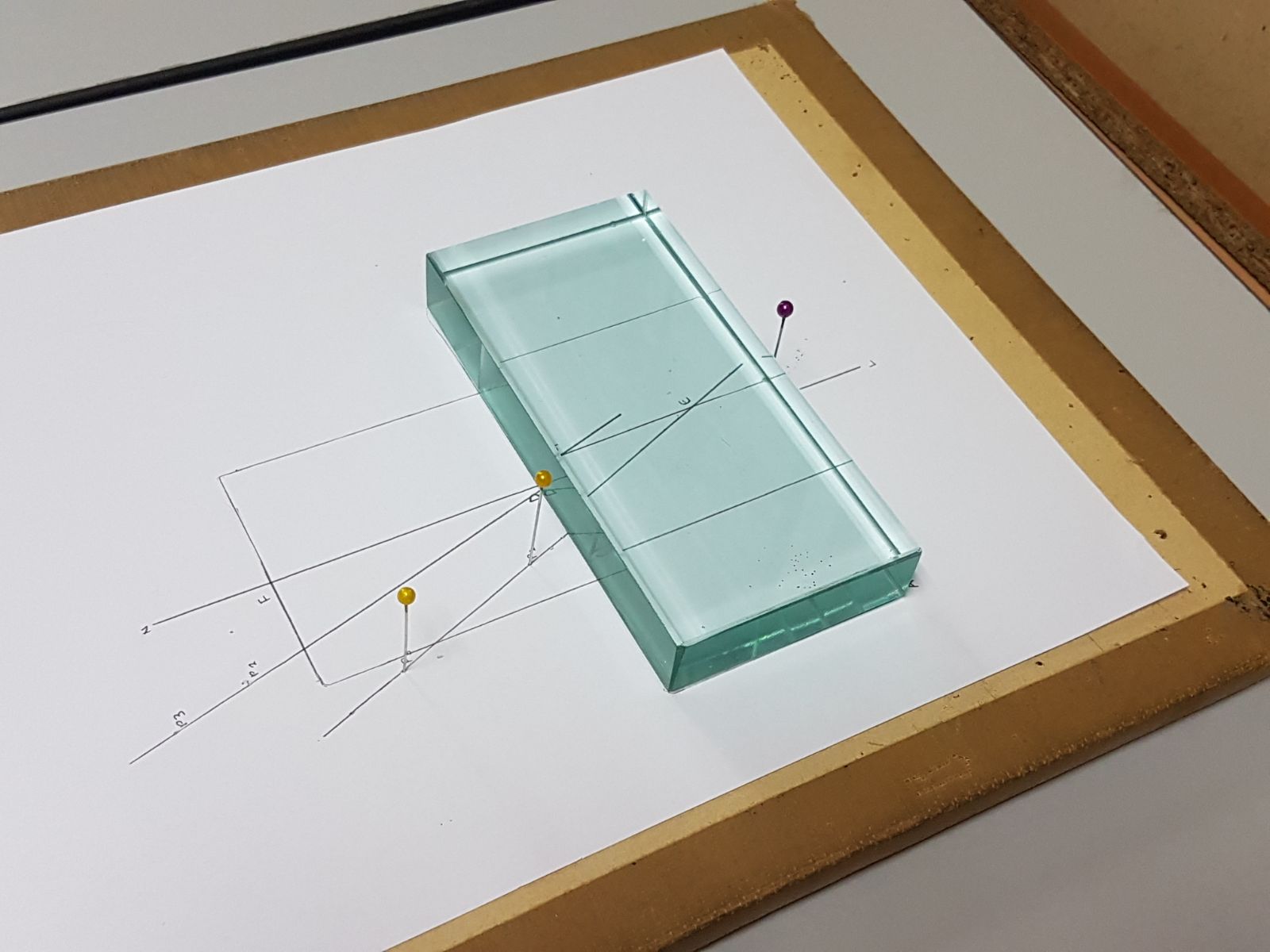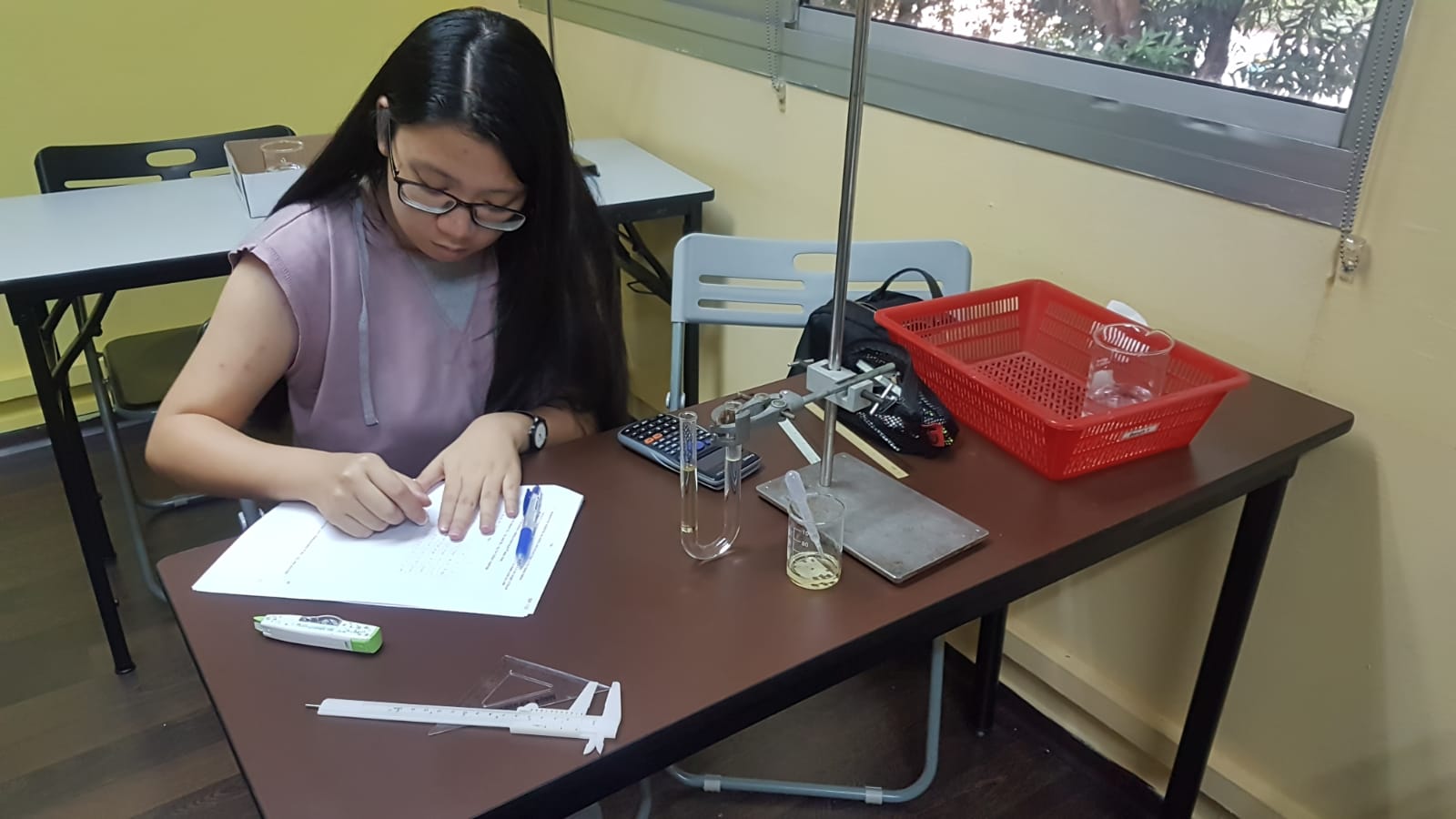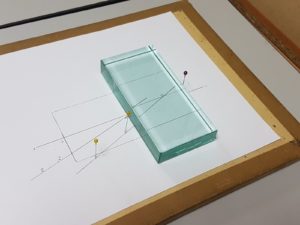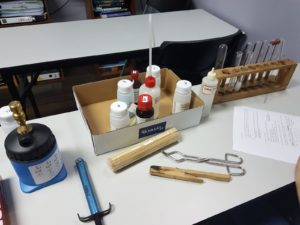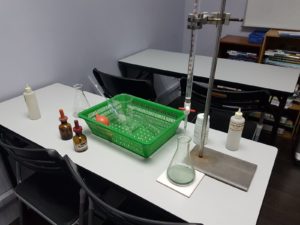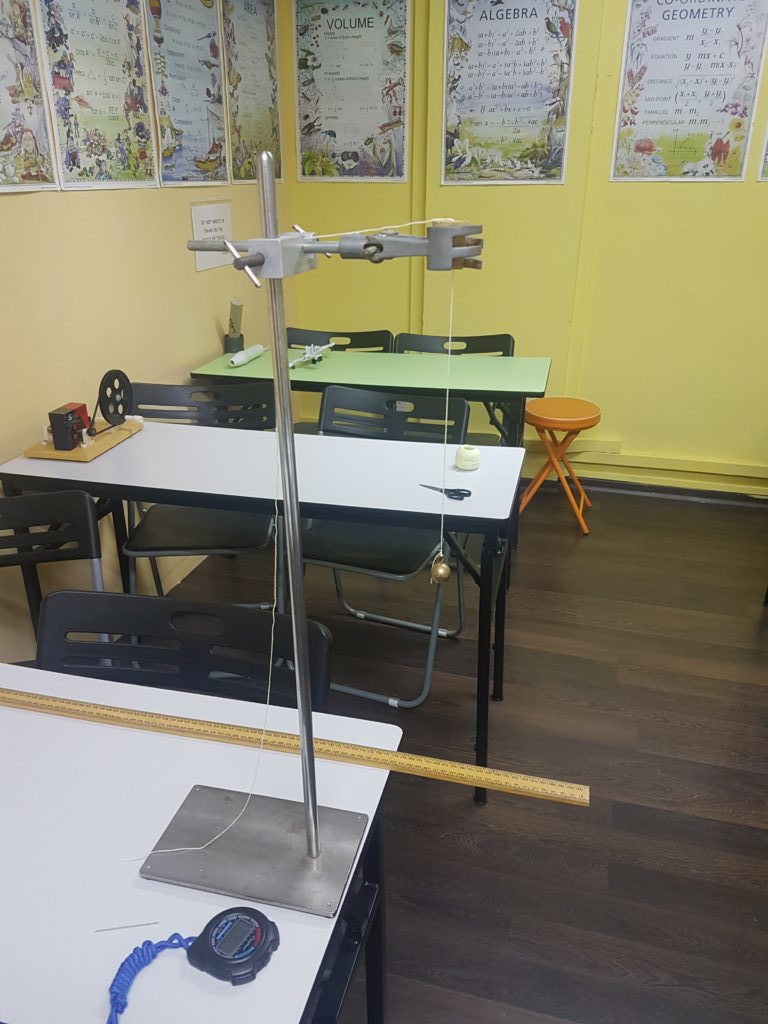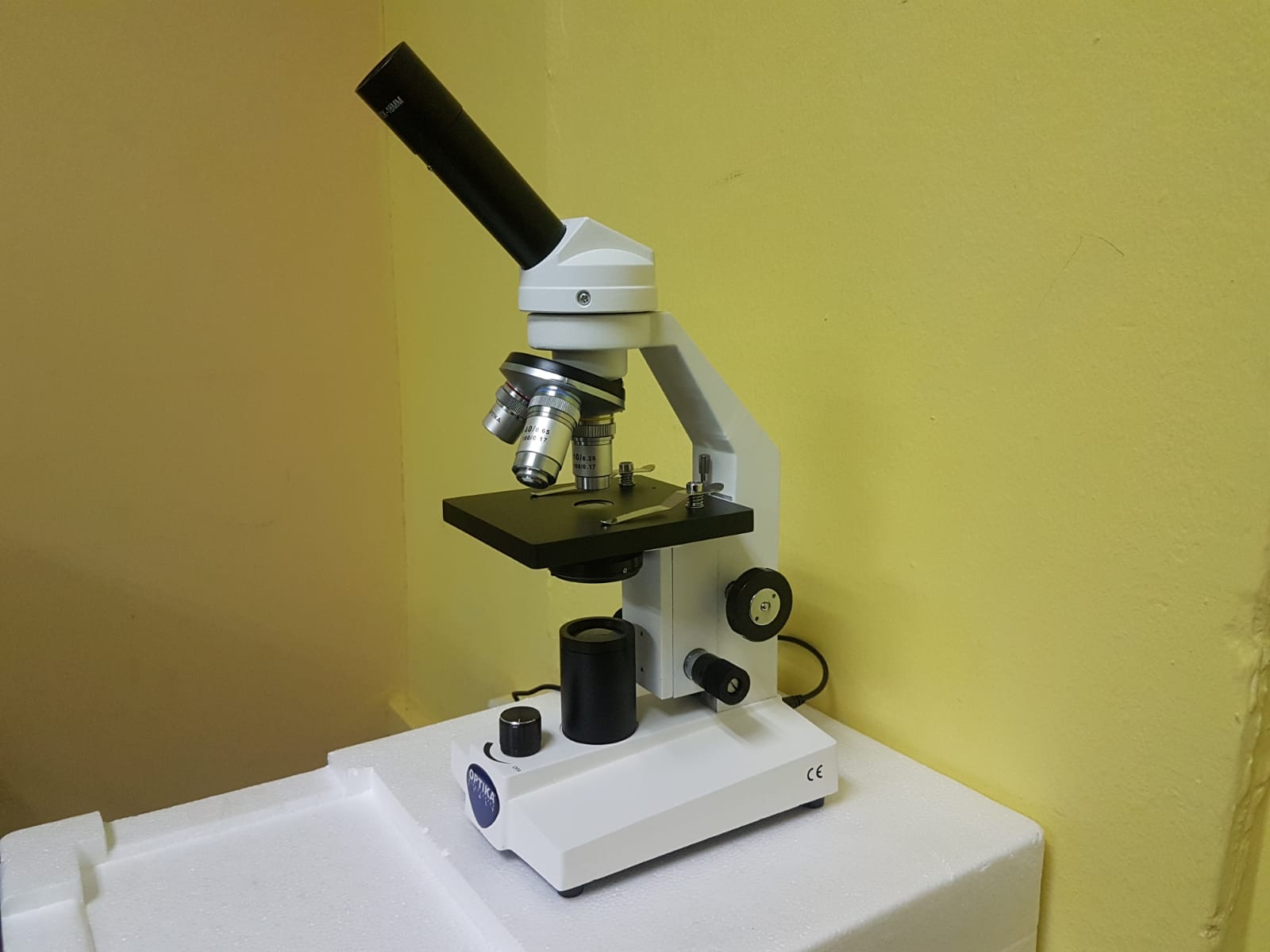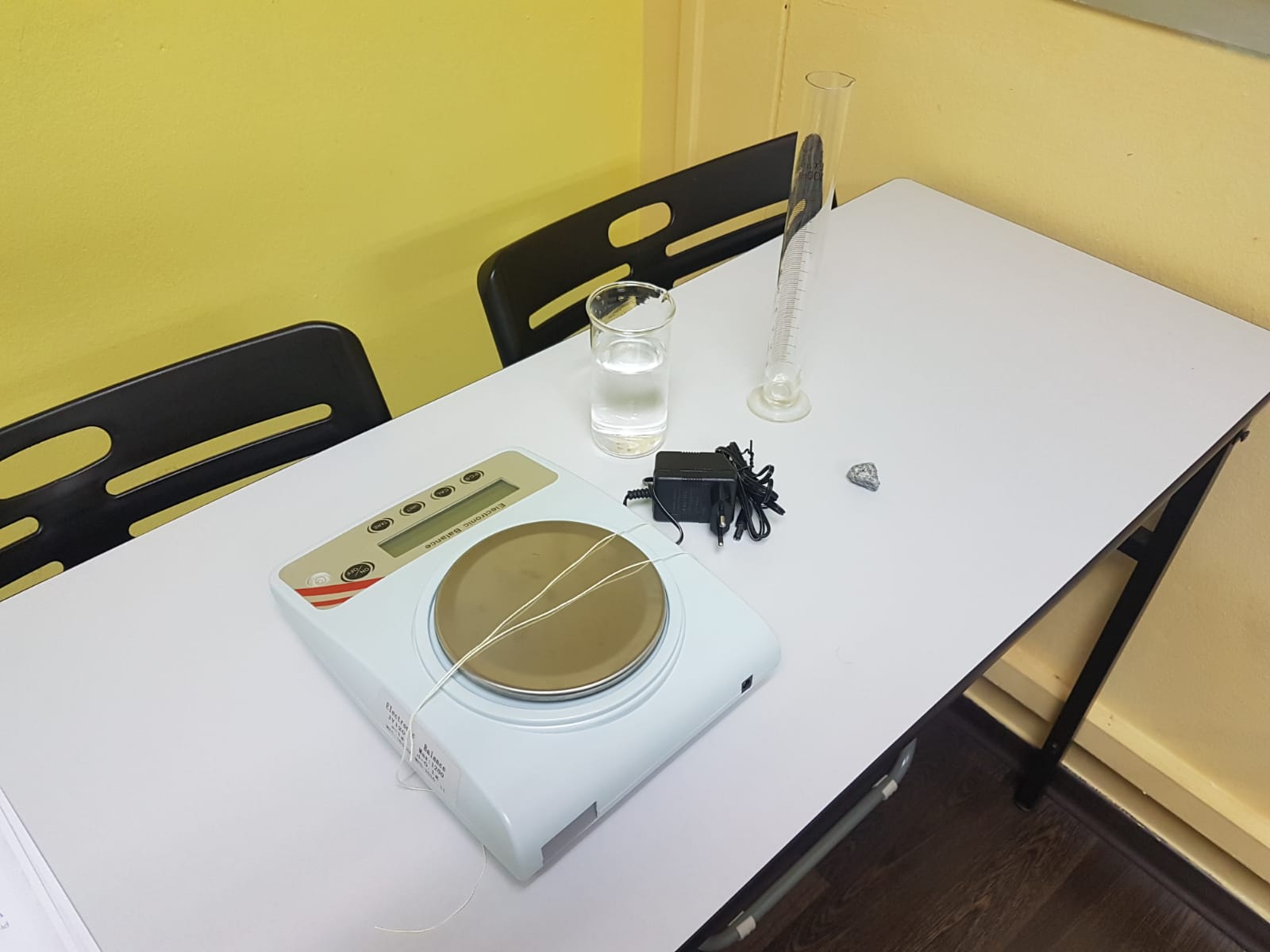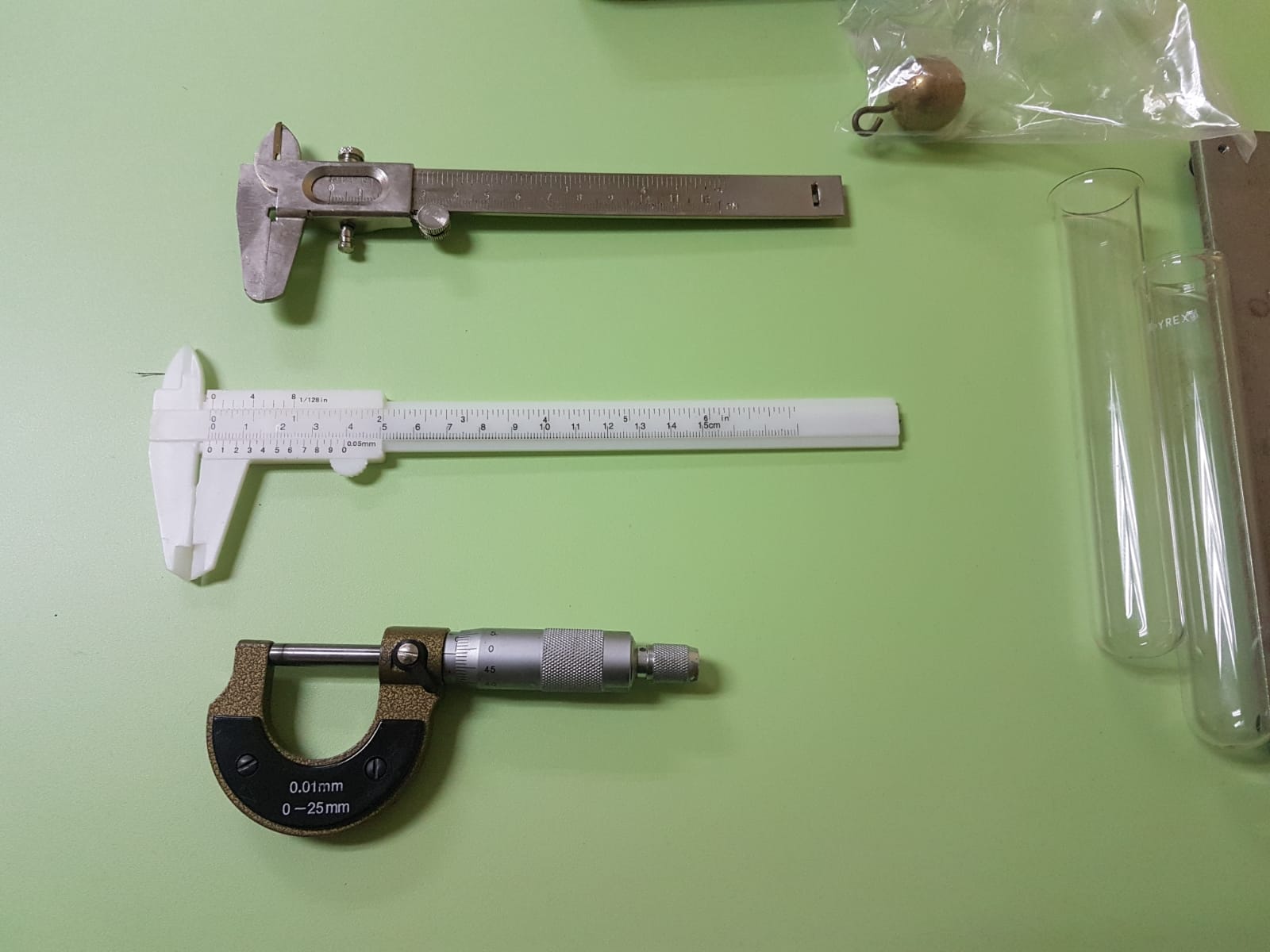We provide A-Level / H2 and O-Level Physics, Chemistry, Biology and Science (Physics/Chemistry/Biology) Practical training for private / school candidates and homeschoolers, for both local (eg. H2, Singapore-Cambridge) and international exams (CIE, IGCSE). School candidates are also welcome.
*Enjoy huge discounts on fees if your lab sessions start in January! Send a message to 88765498 for details.
CIE SYLLABUS FOR CHEMISTRY PRACTICAL
Paper 3 (Practical) is weighted to 23% of the total CIE AS Level assessment.
One question will be an observational problem in which the candidate will be asked to investigate an unknown substance or substances by specified experiments. The substances may be elements, compounds or mixtures. Candidates will be expected to record their observations, analyse their results and draw appropriate conclusions.
The other question or questions will be quantitative: either volumetric analysis or measurement of a quantity, e.g. the enthalpy change of a reaction, mass change on heating, changing the rate of a reaction or measuring a gas volume. Candidates will be expected to draw suitable tables, graphs and other appropriate means of presenting the data. They will analyse the data, perform calculations and draw appropriate conclusions from them.
One or more of the questions may require candidates to comment on the accuracy of the procedure or identify sources of error and make suggestions for change.
Candidates should be able to:
• set up apparatus
• follow instructions given in the form of written instructions or diagrams
• use their apparatus to collect an appropriate quantity of data or observations, including subtle differences in colour, solubility or quantity of materials
• make measurements using pipettes, burettes, measuring cylinders, thermometers and other common laboratory apparatus.
It will be assumed that candidates will be familiar with the following qualitative analysis reactions
(i) the reactions of the following cations: NH4 + , Mg2+, Al 3+, Ca2+, Cr3+, Mn2+, Fe2+, Fe3+, Cu2+, Zn2+, Ba2+
(ii) the reactions of the following anions: CO3 2–, NO3 – , NO2 – , SO4 2–, SO3 2–, Cl – , Br– , I –
(iii) tests for the following gases: NH3, CO2, Cl 2, H2, O2.
In qualitative experiments, precise descriptions and comparisons of colour or other observations are expected. In a titration with a good end-point, candidates are expected to record two titres within 0.10cm3 .
You can book (at least 7 days in advance) any of the following slots for your science practical training:
PRACTICAL TRAINING SCHEDULE
IMPORTANT POINTS TO NOTE:
The above is the ideal schedule for students who want to excel in their CIE CHEMISTRY practical exams, by starting in Jan and having a final practical revision or mock exam in Oct. The practical sessions are well spread out, giving students time to study the theory components as well as other subjects. Thus it is highly recommended that you commence your practical training in January.
HOW TO BOOK A LAB SESSION:
(1) Decide which Program or Lab sessions you need or most suitable for.
(2) Whatsapp or Message our staff at 88765498 with your Name, Private or School Candidate, A or O level, Subject or Lab Name (e.g Lab PP2), Date and Time of Lab. (Our staff will then guide you on how to register and make payment. If you are not sure about the lab sessions, just state your Name and the Subjects and we will get back to you)
(3) Register Online by clicking below:
(4) Pay Registration fee of $50 via Paynow or funds transfer.
(5) Make the required payment for each lab session at least 7 days before the date of the lab session. (You may also pay for several sessions at one go to ensure that you will have a place in future slots)
LAB TOPICS:
Compulsory Labs (HC1 TO HC3):
Lab HC1: TITRATION BASICS AND MOLE CALCULATIONS (TOPICAL TRAINING, LEVEL: BEGINNER) (Available sessions: (CONFIRM WITH ADMIN)
Lab HC2: QA BASICS: TESTING OF GASES AND ANIONS (TOPICAL TRAINING, LEVEL: BEGINNER) (Available sessions: (CONFIRM WITH ADMIN)
Lab HC2A: QA BASICS: TESTING OF CATIONS AND UNKNOWN SALTS (TOPICAL TRAINING, LEVEL: BEGINNER) (Available sessions: (CONFIRM WITH ADMIN)
Lab HC3: GRAVIMETRIC ANALYSIS AND ORDER OF REACTION (TOPICAL TRAINING, LEVEL: BEGINNER)(Available sessions: (CONFIRM WITH ADMIN)
Lab CIE C1: ACID-BASE TITRATION + ENTHALPY (THERMOMETRIC TITRATION) + QA 1 (EXAM PAPER TRAINING, LEVEL: REVISER) Available sessions: (CONFIRM WITH ADMIN)
Lab CIE C2: PERCENTAGE PURITY + ENTHALPY (THERMOMETRIC TITRATION) + QA 2 (EXAM PAPER TRAINING, LEVEL: REVISER) Available sessions: (CONFIRM WITH ADMIN)
Lab CIE C3: RATE OF REACTION + ENTHALPY CHANGE + QA 3 (EXAM PAPER TRAINING, LEVEL: REVISER) (Available sessions: (CONFIRM WITH ADMIN)
Lab CIE C4: THERMOMETRIC TITRATION + ACID-CARBONATE TITRATION + QA 4 (EXAM PAPER TRAINING, LEVEL: REVISER) Available sessions: (CONFIRM WITH ADMIN)
Lab CIE C5: ACID-CARBONATE TITRATION + GRAVIMETRIC ANALYSIS + QA 5 (EXAM PAPER TRAINING, LEVEL: REVISER) Available sessions: (CONFIRM WITH ADMIN)
Lab CIE C6: GAS COLLECTION + GRAVIMETRIC ANALYSIS + QA 6 (EXAM PAPER TRAINING, LEVEL: REVISER) (Available sessions: (CONFIRM WITH ADMIN)
Lab CIE C7: EXTRA LAB
Lab CIE C8: EXTRA LAB
Our Practical Centre:
Singapore Learner @ Bukit Batok
Blk 644, Bukit Batok Central, #01-68. S(650644).
Tel: +(65) 6569 4897, +(65) 88765498 (WHATAPPS ADMIN) http://wa.link/w0xxk2
Email: principal@singaporelearner.com
If you wish to visit us, kindly call or Whatapps first. Thank you.
What you will get at each session:
(1) Teaching and instruction on how to use the various scientific tools and instruments.
(2) Tips on how to answer a practical worksheet or exam paper, including recording of observations, drawing graphs, writing conclusions, describing precautions and planning a practical.
(3) Notes on important aspects of science practicals.
We will also conduct CIE A-Level Mock Practical Exams in April, May, September and October.
HOW TO BOOK A LAB SESSION:
(1) Decide which Program or Lab sessions you need or most suitable for, by visiting the webpages of the practical subjects you are interested in.
(2) Whatsapp or Message our staff at 88765498 with your Name, Private or School Candidate, A or O level, Subject or Lab Name (e.g Lab PP2), Date and Time of Lab. (Our staff will then guide you on how to register and make payment. If you are not sure about the lab sessions, just state your Name and the Subjects and we will get back to you)
(3) Register Online by clicking below:
(4) Pay Registration fee of $50 via Paynow or funds transfer.
(5) Make the required payment for each lab session at least 7 days before the date of the lab session. (You may also pay for several sessions at one go to ensure that you will have a place in future slots)
PRACTICAL TUITION FEES
PRACTICAL DAYS AND TIMINGS
O-LEVEL BIOLOGY PRACTICAL
IGCSE BIOLOGY PRACTICAL
IGCSE BIOLOGY | SCIENCE BIOLOGY PRACTICAL (@Bt Batok):
Session 1: Tuesday 10.00 am – 12.00 pm / 12.30 pm
Session 2: Tuesday 2.00 pm – 4.00 pm / 4.30 pm
Session 3: Tuesday 6.00 pm – 8.00 pm / 8.30 pm
Session 4: Tuesday 8.00 pm – 10.00 pm / 10.30 pm
Singapore Learner @ Bukit Batok
Blk 644, Bukit Batok Central, #01-68. S(650644).
Tel: +(65) 6569 4897, +(65) 9786 0411 (SMS)
Email: principal@singaporelearner.com
If you wish to visit us, kindly call or sms first. Thank you.
What you will get at each session:
(1) Teaching and instruction on how to use the various scientific tools and instruments.
(2) Tips on how to answer a practical worksheet or exam paper, including recording of observations, drawing graphs, writing conclusions, describing precautions and planning a practical.
(3) Notes on important aspects of science practicals.
We also conduct Mock Practical Exams.
FEES PER SESSION
O-LEVEL: $220
A-LEVEL: $320
(The full fee must be paid at least 3 days before the practical session to confirm your attendance as a lot of preparation is needed for practicals coupled with very limited class size. No refund will be given should you fail to turn up.)
To book a Practical session (MUST be at least 3 days in advance),
(1) SMS or Whatsapp the following info to 9786 0411: (a) Name of student; (b) Date and Time; (c) Subject.
(2) Pay $180 (O-level) or $310 (A-level) via cash, cheque or online transfer or Paylah or Paynow. (If you pay for 6 sessions or more you will get 10% off the total fees)
O-LEVEL CHEMISTRY PRACTICAL
We provide A-Level / H2 and O-Level Physics, Chemistry, Biology and Science (Physics/Chemistry/Biology) Practical training for private / school candidates and homeschoolers, for both local (eg. H2, Singapore-Cambridge) and international exams (CIE, IGCSE). School candidates are also welcome.
MOE/SEAB SYLLABUS FOR O-LEVEL CHEMISTRY PRACTICAL
Paper 3 (Practical) is weighted to 20% of the assessment.
Candidates are expected to have been exposed to a range of topics and experimental techniques such as:
1. Titration, e.g. acid-base titration (with suitable indicators such as methyl orange, screened methyl orange,
and thymolphthalein). Other types of titrations may also be required, and where appropriate, sufficient
working details will be given.
2. Speeds of reaction that may involve measuring of quantities, e.g. temperature, volume, length, mass or time
measurements
3. Experiments involving separation techniques such as simple paper chromatography, filtration and distillation
4. Salt preparation
5. Gas collection
6. Qualitative inorganic analysis involving an element, a compound or a mixture, including displacement
reactions and tests for oxidising and reducing agents. Candidates should be familiar with the reactions
of cations, reactions of anions and tests for gases as detailed in the Notes for Qualitative Analysis.
Candidates would not be required to carry out tests involving Pb2+ ions or sulfur dioxide gas.
Reactions involving ions not included in the Notes for Qualitative Analysis may be tested: in such cases,
candidates will not be expected to identify the ions but only to draw conclusions of a general nature.
Candidates should not attempt tests, other than those specified, on substances, except when it is
appropriate to test for a gas.
7. Qualitative organic analysis requiring a knowledge of simple organic reactions as outlined in Section VI,
e.g. test-tube reactions indicating the presence of unsaturation (C=C) may be set, but this would be for
the testing of observation skills and drawing general conclusions only.
SCHEDULE AND FEE MATTERS
Please note we have consolidated all our O-Level Chemistry Practical matters in one page. To view this page, please click on the following link. Thank you!
O-LEVEL CHEMISTRY PRACTICAL
Singapore Learner @ Bukit Batok
Blk 644, Bukit Batok Central, #01-68. S(650644).
Tel: +(65) 6569 4897, +(65) 9786 0411 (SMS)
Email: principal@singaporelearner.com
If you wish to visit us, kindly call or sms first. Thank you.
IGCSE CHEMISTRY PRACTICAL
IGCSE CHEMISTRY| SCIENCE CHEMISTRY PRACTICAL (@Bt Batok):
Session 1: Friday 10.00 am – 12.00 pm / 12.30 pm
Session 2: Friday 8.00 pm – 10.00 pm / 10.30 pm
Session 3: Saturday 9.00 am – 11.00 am / 11.30 am
Singapore Learner @ Bukit Batok
Blk 644, Bukit Batok Central, #01-68. S(650644).
Tel: +(65) 6569 4897, +(65) 9786 0411 (SMS)
Email: principal@singaporelearner.com
If you wish to visit us, kindly call or sms first. Thank you.
What you will get at each session:
(1) Teaching and instruction on how to use the various scientific tools and instruments.
(2) Tips on how to answer a practical worksheet or exam paper, including recording of observations, drawing graphs, writing conclusions, describing precautions and planning a practical.
(3) Notes on important aspects of science practicals.
We also conduct Mock Practical Exams.
FEES PER SESSION
O-LEVEL: $160 (course fee) + $20 (materials fee)
A-LEVEL: $280 (course fee) + $30 (materials fee)
(The full fee must be paid at least 3 days before the practical session to confirm your attendance as a lot of preparation is needed for practicals coupled with very limited class size. No refund will be given should you fail to turn up.)
To book a Practical session (MUST be at least 3 days in advance),
(1) SMS or Whatsapp the following info to 9786 0411: (a) Name of student; (b) Date and Time; (c) Subject.
(2) Pay $180 (O-level) or $310 (A-level) via cash, cheque or online transfer or Paylah or Paynow. (If you pay for 6 sessions or more you will get 10% off the total fees)
O-LEVEL PHYSICS PRACTICAL
O-LEVEL PHYSICS | SCIENCE PHYSICS PRACTICAL (@Bt Batok):
Session 1: Tuesday 10.00 am – 12.00 pm / 12.30 pm
Session 2: Tuesday 8.00 pm – 10.00 pm / 10.30 pm
Session 3: Saturday 9.00 am – 11.00 am / 11.30 am
Session 4: Sunday 11.30 am – 1.30 pm / 2.00 pm
Singapore Learner @ Bukit Batok
Blk 644, Bukit Batok Central, #01-68. S(650644).
Tel: +(65) 6569 4897, +(65) 9786 0411 (SMS)
Email: principal@singaporelearner.com
If you wish to visit us, kindly call or sms first. Thank you.
What you will get at each session:
(1) Teaching and instruction on how to use the various scientific tools and instruments.
(2) Tips on how to answer a practical worksheet or exam paper, including recording of observations, drawing graphs, writing conclusions, describing precautions and planning a practical.
(3) Notes on important aspects of science practicals.
We also conduct Mock Practical Exams.
FEES PER SESSION
O-LEVEL: $160 (course fee) + $20 (materials fee)
A-LEVEL: $280 (course fee) + $30 (materials fee)
(The full fee must be paid at least 3 days before the practical session to confirm your attendance as a lot of preparation is needed for practicals coupled with very limited class size. No refund will be given should you fail to turn up.)
To book a Practical session (MUST be at least 3 days in advance),
(1) SMS or Whatsapp the following info to 9786 0411: (a) Name of student; (b) Date and Time; (c) Subject.
(2) Pay $180 (O-level) or $310 (A-level) via cash, cheque or online transfer or Paylah or Paynow. (If you pay for 6 sessions or more you will get 10% off the total fees)
IGCSE PHYSICS PRACTICAL
IGCSE PHYSICS | SCIENCE PHYSICS (@Bt Batok):
Session 1: Tuesday 10.00 am – 12.00 pm / 12.30 pm
Session 2: Tuesday 8.00 pm – 10.00 pm / 10.30 pm
Session 3: Saturday 9.00 am – 11.00 am / 11.30 am
Session 4: Sunday 11.30 am – 1.30 pm / 2.00 pm
Singapore Learner @ Bukit Batok
Blk 644, Bukit Batok Central, #01-68. S(650644).
Tel: +(65) 6569 4897, +(65) 9786 0411 (SMS)
Email: principal@singaporelearner.com
If you wish to visit us, kindly call or sms first. Thank you.
What you will get at each session:
(1) Teaching and instruction on how to use the various scientific tools and instruments.
(2) Tips on how to answer a practical worksheet or exam paper, including recording of observations, drawing graphs, writing conclusions, describing precautions and planning a practical.
(3) Notes on important aspects of science practicals.
We also conduct Mock Practical Exams.
FEES PER SESSION
O-LEVEL: $160 (course fee) + $20 (materials fee)
A-LEVEL: $280 (course fee) + $30 (materials fee)
(The full fee must be paid at least 3 days before the practical session to confirm your attendance as a lot of preparation is needed for practicals coupled with very limited class size. No refund will be given should you fail to turn up.)
To book a Practical session (MUST be at least 3 days in advance),
(1) SMS or Whatsapp the following info to 9786 0411: (a) Name of student; (b) Date and Time; (c) Subject.
(2) Pay $180 (O-level) or $310 (A-level) via cash, cheque or online transfer or Paylah or Paynow. (If you pay for 6 sessions or more you will get 10% off the total fees)
CIE & IGCSE LEVEL PRACTICAL PHYSICS, CHEMISTRY, BIOLOGY PRACTICAL
GET ‘A’ for CAMBRIDGE INTERNATIONAL CIE & IGCSE LEVEL PRACTICAL PHYSICS / CHEMISTRY / BIOLOGY PRACTICAL
Improve your chances of getting an A for your science courses for IGCSE and CIE by doing well in your practical.
Do well in your practical exams and you are on the way to achieve your targeted grade.
20 % to 23 % of your final grade can be obtained from your practical.
We provide training/coaching and also conduct mock exams for science practical before your actual exam. This can help iron out some mistakes that you might otherwise do in the actual exams.
Practise for your practicals with us. Our experienced tutors will guide you and help you achieve speed and precision in your practical.
You can also prepare for your practicals by taking part in our mock practical exams. Our experienced tutors will observe how you do your practicals within the stipulated time in exam-like conditions. They will then go through the practical paper and give you tips on how to save time, avoid common errors and improve accuracy of your results.
We are equipped for all the 3 sciences and take in a maximum of only 4 students per lab session. This gives a small tutor:student ratio and maximises student learning.
Location: BLK 644, BUKIT BATOK CENTRAL, #01-68. s(650644)
For enquiries, please call our centre at 6569 4897 or whatsapp to 9786 0411 .



RETAKING O-LEVELS
RETAKING YOUR O-LEVELS? JOIN US.
IMPORTANT INFORMATION FOR PRIVATE CANDIDATES
The registration for ‘A’ and ‘O’ Level exams as a private candidate usually opens around mid-April (Please check SEAB website) and closes before mid-May. If you are registering for a Science subject (Physics, Chemistry, Biology or Combined Sciences), at the time of registration, you will be asked whether you have done any science practical training in any school, centre, or institute. Thus you must begin your science practical training before April. Science practical training in Singapore Learner qualifies as practical training for the purpose of registration for Science subjects for the ‘A’ and ‘O’ level exams.
Thus if you are considering Singapore Learner as your science practical training provider, you must register with us and complete at least 4 basic practical sessions for each subject by 31st April for us to certify that you have attended science practical training. As students usually do about 10 practical sessions per subject to be competent in practicals, the rest of the lab sessions can be done from May to early October, including the prelim/mock practical exams.
For Practical courses, mock exams or schedules, please click on any of the following:
Note: Our practical fees are lowest for practicals done in the Jan-Mar period. So sign up now!
O-LEVEL PHYSICS PRACTICAL
O-LEVEL CHEMISTRY PRACTICAL
O-LEVEL BIOLOGY PRACTICAL
Note: For training purposes, Pure and Combined Science students attend the same practical sessions as the syllabus for practicals is the same for both. The only difference between the two kinds of practicals is there are no Planning questions for Combined Science students.
O-LEVEL JUNE HOLIDAYS SCIENCE PRACTICAL REVISION
MOCK EXAMS FOR SCIENCE PRACTICAL 2023
Singapore Learner @ Bukit Batok
Blk 644, Bukit Batok Central, #01-68. S(650644).
Tel: +(65) 6569 4897, +(65) 88765498 (Whatapps Admin) http://wa.link/w0xxk2
Email: singaporelearner@gmail.com
If you wish to visit us, kindly call or sms first. Thank you.
Science Practical Training and Revision for School Candidates
We provide A-Level and O-Level Physics, Chemistry, Biology and Science (Physics/Chemistry/Biology) Practical training and revision for local school candidates.
You can book (at least 3 days in advance) any of the following slots for your science practical training:
A-LEVEL or H2 PHYSICS | O-LEVEL PHYSICS | SCIENCE PHYSICS (@Bt Batok):
Session 2: Tuesday 8.00 pm – 10.00 pm / 10.30 pm
Session 3: Saturday 9.00 am – 11.00 am / 11.30 am
Session 4: Sunday 11.30 am – 1.30 pm / 2.00 pm
O-LEVEL CHEMISTRY| SCIENCE CHEMISTRY (@Bt Batok):
Session 2: Friday 8.00 pm – 10.00 pm / 10.30 pm
Session 3: Saturday 9.00 am – 11.00 am / 11.30 am
Singapore Learner @ Bukit Batok
Blk 644, Bukit Batok Central, #01-68. S(650644).
Tel: +(65) 6569 4897, +(65) 9786 0411 (SMS)
Email: principal@singaporelearner.com
If you wish to visit us, kindly call or sms first. Thank you.
What you will get at each session:
(1) Teaching and instruction on how to use the various scientific tools and instruments.
(2) Tips on how to answer a practical worksheet or exam paper, including recording of observations, drawing graphs, writing conclusions, describing precautions and planning a practical.
(3) Notes on important aspects of science practicals.
We will also conduct Practical Exams in September.
FEES PER SESSION
O-LEVEL: $160 (course fee) + $20 (materials fee)
A-LEVEL: $280 (course fee) + $30 (materials fee)
(The full fee must be paid at least 3 days before the practical session to confirm your attendance as a lot of preparation is needed for practicals coupled with very limited class size. No refund will be given should you fail to turn up.)
To book a Practical session (MUST be at least 3 days in advance),
(1) SMS or Whatsapp the following info to 9786 0411: (a) Name of student; (b) Date and Time; (c) Subject.
(2) Pay $180 (O-level) or $310 (A-level) via cash, cheque or online transfer or Paylah or Paynow. (If you pay for 6 sessions or more you will get 10% off the total fees)
